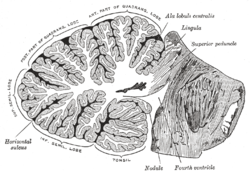| Cerebellum | |
|---|---|
 Drawing of the human brain, showing cerebellum and pons | |
 Vertical midline cross-section of the human cerebellum, showing folding pattern of the cortex, and interior structures | |
| Details | |
| Part of | Metencephalon |
| Artery | SCA, AICA, PICA |
| Vein | Superior, inferior |
| Identifiers | |
| NeuroLex ID | birnlex_1489 |
| TA98 | A14.1.07.001 |
| TA2 | 5788 |
| Anatomical terms of neuroanatomy | |
The Anatomy of the Cerebellum can be viewed at three levels. At the level of gross anatomy, the cerebellum consists of a tightly folded and crumpled layer of cortex, with white matter underneath, several deep nuclei embedded in the white matter, and a fluid-filled ventricle in the middle.[1] At the intermediate level, the cerebellum and its auxiliary structures can be broken down into several hundred or thousand independently functioning modules or compartments known as microzones.[1] At the microscopic level, each module consists of the same small set of neuronal elements, laid out with a highly stereotyped geometry.[2]
- ^ a b Knierim, James. "Chapter 5: Cerebellum". Neuroscience Online: An Electronic Textbook for the Neurosciences.
- ^ Friede, Reinhard L. (1973-03-01). "Dating the development of human cerebellum". Acta Neuropathologica. 23 (1): 48–58. doi:10.1007/BF00689004. ISSN 1432-0533. PMID 4698523. S2CID 5387374.
